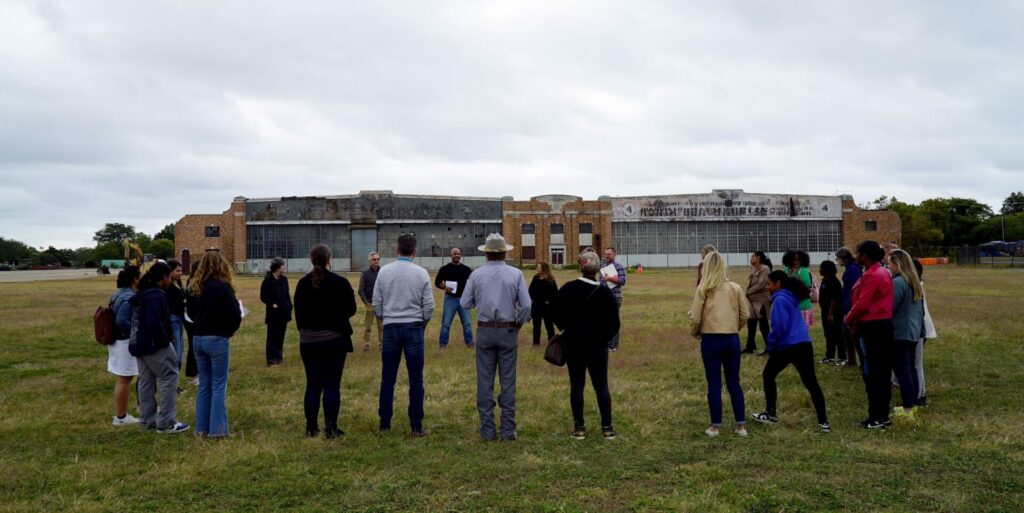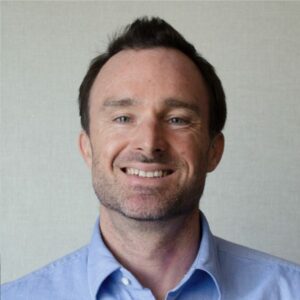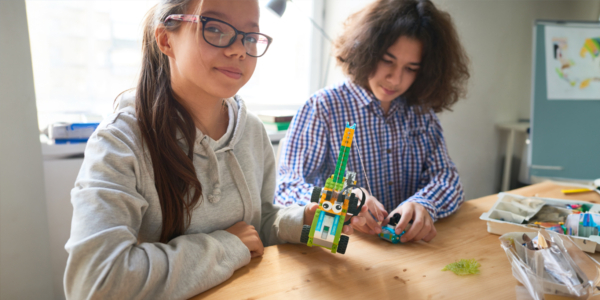Once, a long time ago, the land at the southern tip of Brooklyn was part of a massive ice sheet that swelled and receded for 90,000 years.
Its weight slowly pressed the ground down to bedrock and created an archipelago of islands. In time it was inhabited by the Canarsee, a group of Lenape Native Americans who called it Equindito, or “Broken Lands.”
It was a vibrant natural ecosystem—salt meadows and cedar forests, reed grasses and hay.
Then the Europeans arrived, bringing deceit and disease, and everything changed.
For generations afterward, the land remained sparsely inhabited. But a century ago, a new vision took root: the creation of New York City’s first municipal airport.
The makeover it required was intense: They used sand from nearby Jamaica Bay to fill the gaps between the islands and raise the ground sixteen feet above high-tide. At a time when planes still landed in dirt fields, they laid down five 200-foot-wide concrete runways. And in an era when flying was still something most people had never done, they designed a central terminal building with neoclassical details to remind people of things that were familiar—train stations and post offices.
Named after a Brooklyn native who was the first to fly to the North Pole, Floyd Bennett Field opened in 1931 to a crowd of 25,000 people, an aerial demonstration by Charles Lindbergh, and a flotilla of 600 U.S. Army aircraft.
It was a glorious start, and it was short-lived; in the end, the airfield’s location proved too far from the rest of the city to generate sufficient use, leaving it to gradually resume its natural state.
Across decades, wildflowers sprouted through the cracks in the concrete. Flora wound its way through broken windows and overtook entryways. And aside from a few remote outposts—a random archery field, a racetrack for remote-controlled cars, a rusting climbing tower—Floyd Bennett Field became so completely forgotten that today, most people who live nearby have never even heard of it.
That was how Geoff Roehm and his Launch Middle School colleagues found it when, in 2022, they came to spend a day in retreat, and beheld the ragged beauty of its abandoned landscape.
There must be a school here, they decided—a school that could somehow make this land the primary learning tableau. Yet in the weeks and months that followed, they realized this place required a grander ambition.
Not a single school, but an entire system. Not hundreds of kids, but tens of thousands of them. And not just a general education program, but a highly specialized set of pathways for careers that could create a more sustainable future.
“This part of Brooklyn is a thriving, underappreciated ecosystem,” Roehm explained. “Jamaica Bay has marshy islands and intertidal areas, it has whales and dolphins, and it provides the perfect habitat for more than 300 migratory birds. And right next to it, there’s this abandoned airfield spread across a stretch of land that is 500 acres larger than the entirety of Central Park.”
“What idea is big enough to respond to all those factors? What, we started to wonder, is the wisdom of this place calling out for us to create?”
Nine miles due north, not far from Roehm’s school, the Weeksville Heritage Center in Crown Heights stands as a monument to a different era.
Once home to a vibrant free Black community in pre-Civil War America, Weeksville’s residents established a safe haven for themselves in Brooklyn. They opened schools and churches, fought for abolition, and built houses along a road that led all the way to shellfish beds at the Jamaica Bay end of the Fresh Kills estuary.
For Roehm and his team, therefore, Weeksville felt like the perfect place to share the draft blueprint of the school they intended to build at Floyd Bennett Field—Launch High.
That process began with detailed interviews of neighbors, business owners, parents, and students. They partnered with Transcend, an organization that specializes in helping communities create and spread healthy learning environments. They visited innovative schools elsewhere in the country, including Crosstown High in Memphis, and gradually, they crafted a shared vision of what a school nested within the landscape of Floyd Bennett Field might actually need to look like, and require.
“We’ve realized that this idea is not just a school,” Roehm told a roomful of supporters. “It’s part of what we see as a new design for learning, which is an entire ecosystem. How do we take all the assets that exist within a community and open them up as learning opportunities for kids that are powerful, real, and community-based? That’s a much more powerful way to learn than simply to stay within the four walls of a classroom all day long.”
Indeed, although still nascent, the notion of a learning ecosystem is gaining traction. As The Economist wrote in 2022, “While the COVID-19 pandemic further illuminated the fragilities of traditional education systems, a tremendous collective effort to facilitate learning in innovative ways as a result of the pandemic also generated a new enthusiasm for the concept of learning ecosystems, an interdisciplinary model that moves away from standardised, top-down systems and favours a more integrated and personalised approach that recognises a wider cast of educational providers.”
We’ve realized that this idea is not just a school, it’s part of what we see as a new design for learning, which is an entire ecosystem.
Geoff Roehm, CO-Founder RUnway Green
In a 2023 report commissioned by the Carnegie Foundation for the Advancement of Teaching, Education Reimagined described a learner-centered ecosystem as “an adaptive, networked structure that offers a transformed way of organizing, supporting, and credentialing learning that focuses on nurturing the development of whole human beings within caring communities.” A far cry, in other words, from the Carnegie Unit—the 1906 creation that connects grades to seat time. Yet even the Carnegie Foundation agrees that we need a new approach. “Put succinctly,” they shared in the report’s foreword, “simplistic, time-bound constructions of what knowledge is and how it is acquired do not meet the needs of today’s students, economy, or society. In essence, we need a new version of the Carnegie Unit, which is outcomes based, and allows learning to happen anywhere.”
With these ideas in mind, Roehm’s team established a separate non-profit called Runway Green, and tasked it with coordinating the myriad components of the ecosystem they intended to build—from funders to partners to architects. They commissioned conceptual designs of “a world-class learning environment that will address systemic inequities and prepare young people to tackle the biggest issues of tomorrow.” And they decided to structure Launch High’s program around nine essential skill sets young people need to navigate the modern world, which they could practice and cultivate across three interrelated learning strands: Foundational Academics, Immersive Pathways, and Personal Development.
The school would still prescribe traditional courses, in other words, but it would also ensure that learners got lots of time to explore their own passions—and apply the content in socially relevant ways. Each student would be anchored in a “crew”—a small peer group that stays together with the same advisor for all four years of high school. And after two years of building foundational knowledge, each student would then get to choose a specialized pathway to pursue across their final two years of high school—all relating to the modern challenges of the climate crisis, and the specific skills that are required to address it.
Perhaps, for example, a student’s tenure in the ecosystem helped them fall in love with aquaculture, or green construction, or maybe even marine biology. There would be certified training programs for these and ten other specialties, along with a much longer list of badges and credentials. “We want Floyd Bennett Field to be a place where young people learn about relevant, real-world challenges from experts in our community,” said design member Aysha Khan. “We hope this learning ecosystem breaks down barriers between school and community, empowers students to make positive change, and pushes for a more equitable and inclusive education.”
“People of color and low-income communities will disproportionately feel the impact of climate change in New York City,” Khan continued, “and these same communities already face systemic inequities. But young people are the change agents of the future—and students must be at the forefront of leading the charge to build a better world.”
Last month, I joined Geoff, Aysha, and others for a walking tour of the site.
It was organized by Education Reimagined, a national organization that has convened twelve communities from across the country to develop and pilot designs of learner-centered ecosystems in a variety of contexts and configurations. According to Emily Liebtag, the organization’s Chief Innovation Officer, “As the world’s contexts—democracy, economy, and technology—shift dramatically, we need a modern public system equitably set up for whatever the future might hold. We believe this modern system looks a lot more like an ecosystem—one that is not bound by a single building but rather is a connected network of supports and spaces within a community.”
As the group walked between the airfield’s scattered ruins, Roehm explained how Runway Green and Launch High are working together to coalesce the myriad public-private partnerships that are required to see an idea this big all the way through to reality.
Because the land is federally owned, for example, the National Park Service is a partner. But so, too, is the New York City Department of Education, and the city of New York.
There are design partners. There are investment partners. And then there are all the other organizations who intend to establish their own learning outposts.
SolarOne will manage a solar field here, and offer solar panel workshops where students will earn job credentials while building sustainable energy sources to keep the campus net-zero.
The Campaign Against Hunger will manage a three-acre farm here, where students will gain skills for careers in sustainable agriculture and grow food to feed their neighbors.
New York Sun Works will build and operate world-class science labs here that prepare students for careers in local agriculture and hydroponic farming.
The Billion Oyster Project will establish an ecological lab at Jamaica Bay for students to learn how to save our oceans and prepare for careers in marine biology and advocacy.
NYC Outward Bound Schools will operate an adventure center and support teams of students in building collaboration and communication skills.
There will be campsites, a teaching garden, and an amphitheater.
And all of that will unfold on a seven-acre experiential campus that will support 50,000 K–12 students, from hundreds of NYC public schools, year-round—all of whom will make their way to and from the campus via an eco-friendly transit provider.
“We’re all here because we believe in this idea of interconnected resources and interactive communities,” Roehm told the group. “The future of education will not be a parallel network of isolated schools. The future of education is an ecosystem.”
As the tour ends, I have a few minutes before I need to board the bus, and I wander off the beaten path.
Asphalt quickly shifts to sand, and the beeping of construction vehicles recedes, leaving only the sound of the nearby waves meeting the shoreline.
Birds circle overhead, and I am overtaken by the briny smell of the sea.
No one else is here, and no one has been for a long time—just the land, still hosting the hulking remnants of a once-bustling terminus, slowly bearing the marks of its own chrysalis.
This article is part of a series highlighting sites from Education Reimagined’s Learner-Centered Ecosystem Lab. In collaboration with writer, filmmaker, and global design consultant Sam Chaltain, Education Reimagined is showcasing the development of learner-centered ecosystems in communities across the United States.




